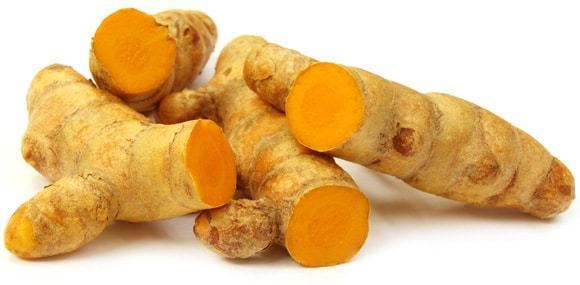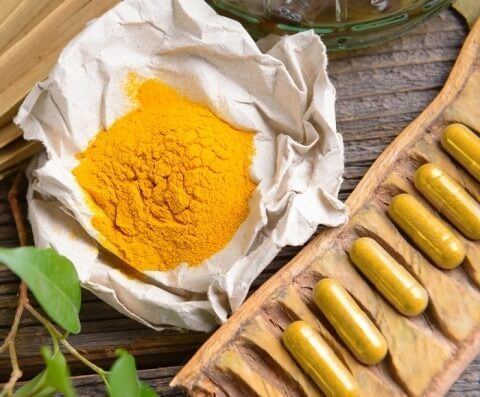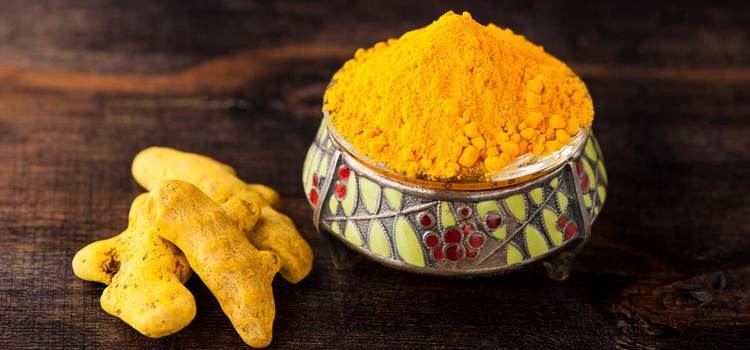Higher classification Hidden-lily | Rank Species | |
 | ||
Similar Ginger, Cumin, Coriander, Spice, Curry | ||
How to plant and grow turmeric
Turmeric (/ˈtɜːrmərɪk/) is a rhizomatous herbaceous perennial plant (Curcuma longa) of the ginger family, Zingiberaceae. It is native to southern Asia, requiring temperatures between 20 and 30 °C (68 and 86 °F) and a considerable amount of annual rainfall to thrive. Plants are gathered annually for their rhizomes and propagated from some of those rhizomes in the following season.
Contents
- How to plant and grow turmeric
- Turmeric harvest 2013 only 1 plant
- History and etymology
- Appearance
- Inflorescence flower and fruit
- Biochemical composition
- Medicinal
- Culinary
- Dye
- Indicator
- Traditional uses
- Adulteration
- Research
- References

When not used fresh, the rhizomes are boiled for about 30–45 minutes and then dried in hot ovens, after which they are ground into a deep-orange-yellow powder commonly used as a coloring in Bangladeshi cuisine, Indian cuisine, Iranian cuisine, Pakistani cuisine, and curries, as well as for dyeing.

Turmeric harvest 2013 only 1 plant
History and etymology

Turmeric has been used in Asia for thousands of years and is a major part of Siddha medicine. It was first used as a dye, and then later for its medicinal properties.
The origin of the name is uncertain, possibly deriving from Middle English/early modern English as turmeryte or tarmaret. Speculation exists that it may be of Latin origin, terra merita (merited earth).
The name of the genus, Curcuma, is from an Arabic name of both saffron and turmeric (see Crocus).
Appearance

Turmeric is a perennial herbaceous plant that reaches up to 1 m (3 ft 3 in) tall. Highly branched, yellow to orange, cylindrical, aromatic rhizomes are found. The leaves are alternate and arranged in two rows. They are divided into leaf sheath, petiole, and leaf blade. From the leaf sheaths, a false stem is formed. The petiole is 50 to 115 cm (20 to 45 in) long. The simple leaf blades are usually 76 to 115 cm (30 to 45 in) long and rarely up to 230 cm (91 in). They have a width of 38 to 45 cm (15 to 18 in) and are oblong to elliptic, narrowing at the tip.
Inflorescence, flower, and fruit
In China, the flowering time is usually in August. Terminally on the false stem is a 12 to 20 cm (4.7 to 7.9 in) long inflorescence stem containing many flowers. The bracts are light green and ovate to oblong with a blunt upper end with a length of 3 to 5 cm.
At the top of the inflorescence, stem bracts are present on which no flowers occur; these are white to green and sometimes, tinged reddish-purple, and the upper ends are tapered.
The hermaphrodite flowers are zygomorphic and threefold. The three 0.8 to 1.2 cm long sepals are fused, white, have fluffy hairs and the three calyx teeth are unequal. The three bright-yellow petals are fused into a corolla tube up to 3 cm long. The three corolla lobes have a length of 1.0 to 1.5 cm, and are triangular with soft-spiny upper ends. While the average corolla lobe is larger than the two lateral, only the median stamen of the inner circle is fertile. The dust bag is spurred at its base. All other stamens are converted to staminodes. The outer staminodes are shorter than the labellum. The labellum is yellowish, with a yellow ribbon in its center and it is obovate, with a length from 1.2 to 2.0 cm. Three carpels are under a constant, trilobed ovary adherent, which is sparsely hairy. The fruit capsule opens with three compartments.
Biochemical composition
The most important chemical components of turmeric are a group of compounds called curcuminoids, which include curcumin (diferuloylmethane), demethoxycurcumin, and bisdemethoxycurcumin. The best-studied compound is curcumin, which constitutes 3.14% (on average) of powdered turmeric, however, there are big variations in curcumin content in the different lines of the species Curcuma longa (1–3189 mg/100g). In addition, other important volatile oils include turmerone, atlantone, and zingiberene. Some general constituents are sugars, proteins, and resins.
Medicinal
Turmeric grows wild in the forests of South and Southeast Asia. Indian traditional medicine, called Siddha, has recommended turmeric for medicine.
Culinary
Turmeric is one of the key ingredients in many Asian dishes. Its use as a coloring agent is not of primary value in South Asian cuisine.
Turmeric is used mostly in savory dishes, but also is used in some sweet dishes, such as the cake sfouf. In India, turmeric plant leaf is used to prepare special sweet dishes, patoleo, by layering rice flour and coconut-jaggery mixture on the leaf, then closing and steaming it in a special copper steamer (goa).
In recipes outside South Asia, turmeric sometimes is used as an agent to impart a golden yellow color. It is used in canned beverages, baked products, dairy products, ice cream, yogurt, yellow cakes, orange juice, biscuits, popcorn color, cereals, sauces, gelatins, etc. It is a significant ingredient in most commercial curry powders.
Most turmeric is used in the form of rhizome powder. In some regions (especially in Maharashtra, Goa, Konkan, and Kanara), turmeric leaves are used to wrap and cook food. Turmeric leaves are mainly used in this way in areas where turmeric is grown locally, since the leaves used are freshly picked. Turmeric leaves impart a distinctive flavor.
Although typically used in its dried, powdered form, turmeric also is used fresh, like ginger. It has numerous uses in East Asian recipes, such as pickle that contains large chunks of soft turmeric, made from fresh turmeric.
Turmeric is used widely as a spice in South Asian and Middle Eastern cooking. Many Persian dishes use turmeric as a starter ingredient. Various Iranian khoresh dishes are started using onions caramelized in oil and turmeric, followed by other ingredients. The Moroccan spice mix ras el hanout typically includes turmeric.
In India and Nepal, turmeric is widely grown and extensively used in many vegetable and meat dishes for its color. It also is used in Nepal for its supposed value in traditional medicine.
In South Africa, turmeric is used to give boiled white rice a golden colour.
In Vietnamese cuisine, turmeric powder is used to color and enhance the flavors of certain dishes, such as bánh xèo, bánh khọt, and mi quang. The powder is used in many other Vietnamese stir-fried and soup dishes.
The staple Cambodian curry paste kroeung, used in many dishes including Amok, typically contains fresh turmeric.
In Indonesia, turmeric leaves are used for Minang or Padang curry base of Sumatra, such as rendang, sate padang, and many other varieties.
In Thailand, fresh turmeric rhizomes are used widely in many dishes, in particular in the southern Thai cuisine, such as the yellow curry and turmeric soup.
In medieval Europe, turmeric became known as Indian saffron because it was used widely as an alternative to the far more expensive saffron spice.
Dye
Turmeric makes a poor fabric dye, as it is not very light fast, but is commonly used in Indian and Bangladeshi clothing, such as saris and Buddhist monks's robes. Turmeric (coded as E100, when used as a food additive), is used to protect food products from sunlight. The oleoresin is used for oil-containing products. A curcumin and polysorbate solution or curcumin powder dissolved in alcohol is used for water-containing products. Over-coloring, such as in pickles, relishes, and mustard, is sometimes used to compensate for fading.
In combination with annatto (E160b), turmeric has been used to color cheeses, yogurt, dry mixes, salad dressings, winter butter, and margarine. Turmeric also is used to give a yellow color to some prepared mustards, canned chicken broths, and other foods (often as a much cheaper replacement for saffron).
Indicator
Turmeric paper, also called curcuma paper or in German literature, Curcumapapier, is paper steeped in a tincture of turmeric and allowed to dry. It is used in chemical analysis as an indicator for acidity and alkalinity. The paper is yellow in acidic and neutral solutions and turns brown to reddish-brown in alkaline solutions, with transition between pH of 7.4 and 9.2.
For pH detection, turmeric paper has been replaced in common use by litmus paper. Turmeric may be used as a substitute for phenolphthalein, as its color change pH range is similar.
Traditional uses
In Ayurvedic practices, turmeric has been used as an attempted treatment for a variety of internal disorders, such as indigestion, throat infections, common colds, or liver ailments, as well as topically, to cleanse wounds or treat skin sores.
Turmeric is considered auspicious and holy in India and has been used in various Hindu ceremonies for millennia. It remains popular in India for wedding and religious ceremonies.
Turmeric has played an important role in Hindu spiritualism. The robes of the Hindu monks traditionally were colored with a yellow dye made of turmeric. Because of its yellow-orange coloring, turmeric was associated with the sun or the Thirumal in the mythology of ancient Tamil religion. Yellow is the color of the solar plexus chakra which in traditional Tamil Siddha medicine is an energy center. Orange is the color of the sacral chakra.
The plant is used in Poosai (Tamil) to represent a form of the Tamil Goddess Kottravai.
In Eastern India, the plant is used as one of the nine components of navapatrika along with young plantain or banana plant, taro leaves, barley (jayanti), wood apple (bilva), pomegranate (darimba), asoka, manaka or manakochu, and rice paddy. The Navaptrika worship is an important part of Durga festival rituals.
It is used in poosai to make a form of Ganesha. Yaanaimugathaan, the remover of obstacles, is invoked at the beginning of almost any ceremony. A form of Yaanaimugathaan for this purpose is made by mixing turmeric with water and forming it into a cone-like shape.
Haldi ceremony (called Gaye holud in Bengal) (literally "yellow on the body") is a ceremony observed during Hindu wedding celebrations in many parts of India including Bengal, Punjab, Maharashtra, and Gujarat. The 'ceremony takes place one or two days before the religious and legal Bengali wedding ceremonies. The turmeric paste is applied by friends to the bodies of the couple. This is said to soften the skin, but also colors them with the distinctive yellow hue that gives its name to this ceremony. It may be a joint or separate event for the families of the bride and groom. During the Tamil festival Pongal, a whole turmeric plant with fresh rhizomes is offered as a thanksgiving offering to Suryan, the sun deity. Also, the fresh plant sometimes is tied around the Pongal pot in which an offering of pongal is prepared.
In Tamil Nadu and Andhra Pradesh, as a part of the Tamil/Telugu marriage ritual, dried turmeric tuber tied with string is used to create a Thali necklace, the equivalent of marriage rings in western cultures. In western and coastal India, during weddings of the Marathi and Konkani people, Kannada Brahmins turmeric tubers are tied with strings by the couple to their wrists during a ceremony called Kankanabandhana.
Friedrich Ratzel reported in The History of Mankind during 1896, that in Micronesia, turmeric powder was applied for embellishment of body, clothing, utensils, and ceremonial uses.
Adulteration
As turmeric and other spices are commonly sold by weight, the potential exists for powders of toxic, cheaper agents with a similar color to be added, such as lead(II,IV) oxide, giving turmeric an orange-red color instead of its native gold-yellow. Another common adulterant in turmeric, metanil yellow (also known as acid yellow 36), is considered an illegal dye for use in foods by the British Food Standards Agency.
Research
Claims that curcumin in turmeric may help to reduce inflammation have not been supported by strong studies.
Turmeric or its principal constituent, curcumin, has been studied in small clinical trials for various human diseases and conditions, but the quality of research has not been adequate to allow definitive conclusions.
